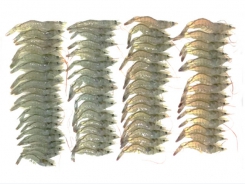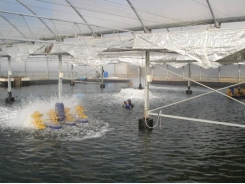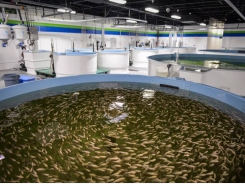Top 10 tips for shrimp farming – the basics - Part 1

Shrimp farming isn't easy - but getting the basics right can keep your ponds productive and disease-free.
Farmers should take regular samples of shrimp to ensure they are using feed efficiently
Shrimp farming requires hundreds of activities on a daily basis. As Alune learns from, works with and designs standard operating procedures (SOPs) and data solutions for farms around Indonesia, we have been keeping a list of our top tips. Some you will know, but some we hope will be new and useful for your farm.
1. Sterilise everything
Sterilisation is an important step to provide a disease-free environment for the shrimp. Before stocking begins, it is important to sterilise all aspects of the farm – the pond itself, all the equipment and the culture water – to make sure that pathogens are eradicated and the risk of disease minimised.
Here's how to start:
Pond and equipment sterilisation
First, clean the pond and equipment with high pressure spray containing disinfectants. It is recommended to use 10 ppm of trichloroisocyanuric acid (TCCA) and 30 ppm of sodium hypochlorite. See below for the recommended exposure time and concentrations for chlorine disinfection.
After disinfection, scrub the pond lining to make sure that the biofilm is lifted. Then, remove all the leftover sludge from the previous cycle as this is a source of pathogens and harmful components. If the farm suffered from disease outbreak in the previous cycle, use lime with a pH up to 11 to eradicate spores and prevent further outbreaks in the next cycle.
Water sterilisation
Water sterilisation requires two steps: prefiltration and disinfection. For prefiltration, use filters with a mesh of less than 200-300 microns at the water inlet to prevent entry of pathogens, predators and undesirable settleable solids. The filters should be maintained regularly by rinsing them with clean water and removing any deposits.
As for water disinfection, use chemical disinfectants to eradicate all the pathogens. Apply 20–30 ppm of sodium hypochlorite 60 percent, 0.5–2.5 ppm of KMnO4 and 10 ppm of TCCA to the filtered water for 24 hours. Maintain full aeration during chemical disinfection. To remove the leftover chlorine, use the right amount of sodium thiosulphate by multiplying the leftover chlorine concentration by three. Finally, apply it two to seven times over 24 hours.
Biosecurity is one of the key ways to prevent disease infection in a farm and also further outbreaks in the region; it benefits not only one farmer but also the whole neighbourhood.
2. Improve your biosecurity
In shrimp farming, biosecurity is often disregarded as a mere addition of unnecessary infrastructure and complex procedures with unclear monetary benefit. However, the importance of biosecurity cannot be overstated since it is one of the key ways to prevent disease in a farm and also further outbreaks in the region; it benefits not only one farmer but also the whole neighbourhood.
Biosecurity works by preventing pathogen entry and excluding pathogens from the farm. Here are some of the simplest biosecurity measures you can start to implement at your farm.
Use a pond liner – the most commonly used material is high-density polyethylene (HDPE). Using a pond liner allows easier water control since the water does not interact directly with soil, an interaction that could trigger a complex anoxic reaction, which is highly toxic for the shrimp.
Protect the farm with fences – to prevent wild animals, such as crabs, which may carry undesirable pathogens, from entering.
Control the movement of people and vehicles – it is important to make sure that all employees and visitors go through disinfection and cleaning procedures before and after entering and working. All vehicles should go through the same procedures before entry and exit.
Place feed and probiotics in a specific storage room – to maintain cleanliness, prevent contact with outside vectors which may carry disease, and to provide a more stable temperature for better feed maintenance.
Make sure there are labs available in the area – labs are important for two essential things: assessing water quality and checking for diseases. Having a reliable lab in your area is highly beneficial, as doing these checks locally is much quicker than, for example, sending your water or shrimp sample to another city.
Simple biosecurity measures like nets and pond liners can go a long way towards preventing disease outbreaks
3. Maintain optimum alkalinity level
Alkalinity is one of the most critical water quality parameters since it directly affects pH fluctuation and bacterial composition. It is recommended to maintain alkalinity at 120–150 ppm. Maintenance of alkalinity can be done by applying bicarbonate compounds, such as CaCO3, CaMg(CO3)2, CaO, and Ca(OH)2. It is better to apply treatment periodically rather than when alkalinity spikes occur. To maximise alkalinity increase, the amount applied at each treatment time should not be more than 20 ppm.
To know the right amount of bicarbonate compounds to be applied, you need to know the current alkalinity concentration, which is why periodic measurement is important. This simple formula might help:
(target alkalinity - current alkalinity concentrations)*2
Alkalinity treatment is recommended to be done at night or early morning. Bicarbonate compounds will react with carbon dioxide (CO2) which are more available at night due to respiration of all organisms.
4. Calibrate all your measurement tools
It might seem simple but before every cycle make sure that all your measurement tools are calibrated. This includes your dissolved oxygen (DO) meter, pH meter, refractometer and chemical test kit. Uncalibrated tools might cause a significant error which may lead to grave mismanagement due to inaccurate data. Calibrated tools may help you gain more accurate data on the conditions of the farm and allow them to make more educated decisions.
5. Assess post-larvae (PL) and shrimp health
Before stocking, PL from hatcheries should be checked regularly – by sight or, even better, by microscope. Shrimp health should also be assessed once a week after stocking. This is beneficial for maintaining optimal shrimp growth and detecting possible signs of disease. The key things to check are if:
- The shrimp are swimming actively
- Their morphology is normal
- Their guts are full
- They have no adhering organisms
- There is no cloudiness in the muscle
- The muscle to gut width ratio is 3:1
- The hepatopancreases are large and dark
- The gill is white or greyish
- There is no melanisation (shown by black to brownish spots)
- There is no moulting residue on the shrimp heads
- There are no cuts or twists on their bodies
Related news
Tools

Phối trộn thức ăn chăn nuôi

Pha dung dịch thủy canh

Định mức cho tôm ăn

Phối trộn phân bón NPK

Xác định tỷ lệ tôm sống

Chuyển đổi đơn vị phân bón

Xác định công suất sục khí

Chuyển đổi đơn vị tôm

Tính diện tích nhà kính

Tính thể tích ao




 Top 10 tips for shrimp farming – the…
Top 10 tips for shrimp farming – the…  Top tips for setting up a recirculating aquaculture…
Top tips for setting up a recirculating aquaculture…